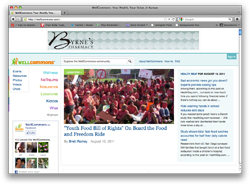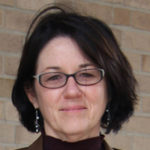Prototype to revenue stream: Reynolds Fellow starts multiple social journalism sites based on fellow
If you’ve ever wondered what happens to big ideas once they leave the Reynolds Journalism Institute, check out 2008-2009 Reynolds Fellow Jane Stevens’ update below. She has taken the knowledge gained from her fellowship project, Niche News Network, and created successful social journalism websites in Lawrence, Kansas.
It’s been an amazing, nonstop, jam-packed two years at the World Company, in Lawrence, KS, which publishes LJWorld.com, KUSports.com, three other niche sites, a group of community sites in Northeast Kansas, and the Lawrence Journal-World print edition. I came to Lawrence after my RJI fellowship to develop a local health social journalism site for Lawrence, KS, the seminal node of a niche news network, based on a prototype developed during the fellowship.

WellCommons, our first social journalism site, is 16 months old, and it’s doing quite well (it seems to be at or ahead of other digital-native enterprises at this same age). We just passed 156,000 page views (last 30 days), with 35,000 unique visitors. We expect to hit 200,000 sometime in September. Our community is very happy with it. Our goal was to have half the content coming from the community, and we’re hitting that at least three days a week now. We don’t solicit content — we just gave the community the same tools that we use, and their posts go into the WC home page news stream. We throw most to the news stream of LJworld.com.
Starting a social journalism site requires a lot of education and training in the community. Members of our community refer to it as “my” site. Like “my” newspaper. We involved the community from the get-go, from the design stage on. They asked for real names, so we require them for posting content. We’re allowing anonymous comments, but are strictly moderating them for civility and staying on topic. There are more than 2,600 members (we’re changing this to “followers” and “contributors” soon) and 130+ groups on WC so far. When it’s two years old, we expect about 250,000 page views a month.
When we started WellCommons, we hoped for two things:
- that the site would become the go-to place for local health news for our community;
- and that members of our community involved and interested in health would consider the site theirs, and want to post their news and information, thoughts and essays to the site.
What we learned about building a social journalism site is that the site architecture is critical. We made it work more or less like Facebook, in the sense that anyone who uses her or his real name can post content directly to the site. This content is integrated with content produced by our reporter. We monitor the site to make sure the content is topically appropriate and not abusive, but we don’t edit content. As one person said on Twitter: “They let the people in!” Groups are the core of any community and its ability to address its challenges. So, like Google+ Circles, WellCommons’ group pages are the backbone of WellCommons. People and organizations, including businesses, have started more than 130 groups, which more than 2,000 people have joined.
Site architecture is only half the equation. It takes a community to grow a site like WellCommons. We involved our community while we were developing the site, and changed our plans based on their feedback. We released a site that wasn’t “finished”, in our minds, because we needed to see how our community used the site to figure out what worked and what didn’t, and then make adjustments. Six months after we launched the beta, we upgraded it to WellCommons 2.0. By listening, asking and changing, our local health community has engaged with WellCommons and has become very proprietary about the site.
Our goal for the site was to have at least 10 posts a day — based on some pretty good research, that’s the amount of content that grows page views and unique visitors. We also wanted at least half of the posts every day to come from the community. We’re hitting or surpassing 10 posts a day nearly every day, and on two or three days a week, half of that content comes from the community. By the end of the year, we expect the community to provide half the daily content. This allows our reporter to focus on the stories that require her skills, and the site catches “the long tail” of health news and information in the community.
A while ago, when we were gathering information to submit WellCommons for an award, we asked a few people if they thought WellCommons was useful to the community. The most pertinent response was this one from Marilyn Hull, LiveWell Lawrence facilitator:
“One solution Wellcommons provides is that it puts us in the driver’s seat. I used to send news releases to the paper, and they seldom resulted in stories. Now, we don’t have editors deciding what is newsworthy. We get to post our news, and then our community can decide if it is worth reading.”
As is our responsibility as journalists, we have created a safe place and a trusted source for people to put their content and have conversations. As a result of this input, and our track record over the last 16 months, the Associated Press Managing Editors awarded WellCommons the Innovator of the Month award. It wasn’t Innovator of the Year, as we’d hoped, but our managing editor, Dennis Anderson, who’s on the APME board, says it’s like getting second place. And that’s something to crow about, considering our competitors are thousands of news organizations across the U.S., many of them a LOT larger and with more resources than the World Company.
We’ve also been receiving some other national attention. Nieman Reports magazine published an account I wrote about WellCommons’ development, and Streetfight.com, a site that focuses on new local news sites, did a Q-and-A. A couple of people — one from USC’s Annenberg School for Communications and a professor at Drury University — are doing long-term case studies of the site development.
We’re not resting on our laurels. We know that we still have a lot of work to do to make WellCommons more useful. We need a good resource and database section, topics pages and a goals application. Those three pieces would complete my goal of creating a site that is truly solution-oriented, that gives the community the tools to solve its problems and address its challenges. Nevertheless, the site has been successful enough that we recently launched SunflowerHorizons.com, a sustainability site that covers energy and the environment, using the same WellCommons template. The revenue track record is promising, too. WellCommons has enough annualized revenues to support one reporter and part of the staff time necessary to support the site (editor, developers, accounting, etc.), and, eventually, we anticipate being able to support two reporters.
To learn more about the Reynolds Fellowship program, click here or contact Kelly Peery.

Comments